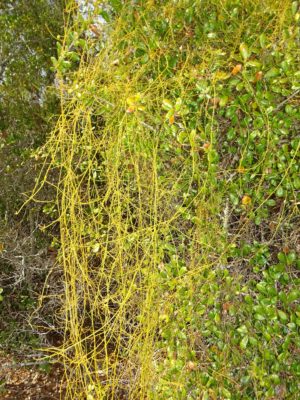
Love vine, Cassytha filiformis, is a parasitic vine native to Florida in the Lauraceae family, the same family as avocado. While the name “love vine” stems from its reputation as an aphrodisiac, this plant is anything but sweet! As a parasitic vine, it twines itself around host branches and then penetrates the host’s tissues with specialized appendages called haustoria that resemble tiny suction cups. Once attached, haustoria absorb water and nutrients from the host. While it does not typically kill the host plant, it can adversely affect the health of the tree and reduce its reproductive capacity.

Not only does the love vine parasitize other plants, a study in 2018 suggests that it is also a type of parasite of several gall wasps, including oak gall wasps (Belonocnema treatae). The larvae of some parasitic wasps secrete growth hormones to encourage trees to grow galls – spherical growths that supply the wasp larvae with a home and a reliable supply of water and nutrition. Researchers from Rice University discovered that love vine appears to target several species of insect galls and uses its haustoria to penetrate the galls, sucking out the water and mineral nutrients, thereby reducing those available to the wasp and potentially killing it. In other words, it may be considered a hyperparasite – a parasite that benefits at the expense of another parasite! Be sure to keep an eye out for this unique relationship and upload your observations.
Love vine stems attaching to oak galls on the undersides of oak leaves.

Love vine is widespread, found in the Americas, the Virgin Islands, the Caribbean, Mexico, Africa, Asia, Australia and the Pacific. In the US, it is native to Florida, Texas, and Hawaii. Here in Florida, we can find Cassytha filiformis in our scrub, coastal, and hammock habitats, twining up and around a variety of hosts, including live oaks. Love vine is a nearly leafless perennial, with stems that are yellow or orange, or sometimes completely green. It is unclear how much the love vine can produce food on its own through photosynthesis, but it’s need for water and nutrients from the host has been shown. The flowers are greenish-white and its berries emerge green, then turn white as they mature, and eventually turn black. It flowers May-July. While not a friend to the host tree or gall wasp, birds and mammals do enjoy the fruit and help to spread the seeds.
Now that we know what to look for and where this month, let’s start lookin’ for love vine, in all the right places!
